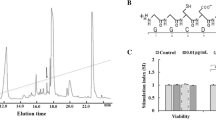Abstract
The bursa of Fabricius (BF) is the central humoral immune organ unique to birds. Here, we isolated a novel bursal pentapeptide I (BPP-I), LGPGP, from BF. BPP-I could play inhibition effect on MCF-7 but not on CEF or Vero cell proliferation in vitro, and enhance antitumor factor p53 protein expression. Also, BPP-I stimulated antibody production in a dose-dependent manner in hybridoma cell. Furthermore, BPP-I could induce various immune responses in mice immunization experiments, including increase antibody production and cytokines IL-4 and IFN-γ level, and induce T-cell immunophenotyping. These results suggest that BPP-I is a potential immunomodulator of antitumor and immunity. The study could provide some novel insights on the probable candidate reagent for the antitumor and immune improvement.





Similar content being viewed by others
References
Ann B, Douglas GG, Gideon G (1976) Lymphocyte-differentiating hormone of bursa of Fabricius. Science 193:319–321
Arakawa H, Buerstedde JM (2004) Immunoglobulin gene conversion: insights from bursal B cells and the DT40 cell line. Dev Dyn 229:458–464
Avantika V, Kashi NP, Aloukick KS, Kishan KN, Rakesh KG, Vimal KP (2010) Evaluation of the MTT lymphocyte proliferation assay for the diagnosis of neurocysticercosis. J Microbiol Methods 81(2):175–178
Baba T, Kita M (1977) Effect of extracts of the bursa of Fabricius on IgG antibody production in hormonally bursectomized chickens. Immunology 32:271–274
Bou Ghanem EN, Nelson CC, D’Orazio SE (2011) T cell-intrinsic factors contribute to the differential ability of CD8+ T cells to rapidly secrete IFN-γ in the absence of antigen. J Immunol 186(3):1703–1712
Bungener L, Geeraedts F, Ter Veer W, Medema J, Wilschut J, Huckriede A (2008) Alum boosts TH2-type antibody responses to whole-inactivated virus influenza vaccine in mice but does not confer superior protection. Vaccine 26(19):2350–2359
Byrd JA, Dean CE, Hayes TK, Wright MS, Hargis BM (1993) Detection and partial characterization of an anti-steroidogenic peptide from the humoral immune system of the chicken. Life Sci 52:1195–1207
Caldwell DJ, Dean CE, McElroy AP, Caldwell DY, Manning JG, Hargis BM (1999) Bursal anti-steroidogenic peptide (BASP): modulation of mitogen-stimulated bursallymphocyte DNA synthesis. Comp Biochem Physiol A Mol Integr Physiol 123(4):385–391
Caldwell RB, Kierzek AM, Arakawa H, Bezzubov Y, Zaim J, Fiedler P, Kutter S, Blagodatski A, Kostovska D, Koter M, Plachy J, Carninci P, Hayashizaki Y, Buerstedde JM (2005) Full-length cDNAs from chicken bursal lymphocytes to facilitate gene function analysis. Genome Biol 6(1):R6
Davison F, Kaspers B, Schat KA (eds) (2008) Avian Immunology, Elsevier/Academic Press, New York
Feng XL, Su XD, Wang FQ, Wei JC, Wang FJ, Cao RB, Zhou B, Mao X, Zheng QS, Chen PY (2010) Isolation and potential immunological characterization of TPSGLVY, a novel bursal septpeptide isolated from the bursa of Fabricius. Peptides 31:1562–1568
Gajewski TF, Chesney J, Curriel TJ (2009) Emerging strategies in regulatory T-cell immunotherapies. Clin Adv Hematol Oncol 7(1):1–10 (quiz 11–12)
Jones HP, Wang YC, Aldridge B, Weiss JM (2008) Lung and splenic B cells facilitate diverse effects on in vitro measures of antitumor immune responses. Cancer Immun 8:4
Kim E, Deppert W (2003) The complex interactions of p53 with target DNA: we learn as we go. Biochem Cell Biol 81(3):141–150
Lacroix M, Leclercq G (2004) Relevance of breast cancer cell lines as models for breast tumours: an update. Breast Cancer Res Treat 83(3):249–289
Li DY, Geng ZR, Zhu HF, Wang C, Miao DN, Chen PY (2010) Immunomodulatory activities of a new pentapeptide (Bursopentin) from the chicken bursa of Fabricius. Amino Acids. doi:10.1007/s00726-010-0663-7
Makde RD, England JR, Yennawar HP, Tan S (2010) Structure of RCC1 chromatin factor bound to the nucleosome core particle. Nature 467(7315):562–566
May P, May E (1999) Twenty years of p53 research: structural and functional aspects of the p53 protein. Oncogene 18(53):7621–7636
Nicolini A, Carpi A (2009) Immune manipulation of advanced breast cancer: an interpretative model of the relationship between immune system and tumor cell biology. Med Res Rev 29(3):436–471
Ohtsubo M, Kai R, Furuno N, Sekiguchi T, Sekiguchi M, Hayashida H, Kuma K, Miyata T, Fukushige S, Murotsu T et al (1987) Isolation and characterization of the active cDNA of the human cell cycle gene (RCC1) involved in the regulation of onset of chromosome condensation. Genes Dev 1(6):585–593
Qiu Y, Shen Y, Li X, Liu Q, Ma Z (2008) Polyclonal antibody to porcine p53 protein: a new tool for studying the p53 pathway in a porcine model. Biochem Biophys Res Commun 377(1):151–155
Ratcliffe MJH (2006) Antibodies, immunoglobulin genes and the bursa of Fabricius in chicken B cell development. Dev Comp Immunol 30:101–118
Seder RA, Paul WE, Davis MM, Fazekas de St Groth B (1992) The presence of interleukin 4 during in vitro priming determines the lymphokine-producing potential of CD4 + T cells from T cell receptor transgenic mice. J Exp Med 176(4):1091–1098
Shen Y, Wang X, Guo L, Qiu Y, Li X, Yu H, Xiang H, Tong G, Ma Z (2009) Influenza A virus induces p53 accumulation in a biphasic pattern. Biochem Biophys Res Commun 382(2):331–335
Singh VK, Biswas S, Mathur KB, Haq W, Garg SK, Agarwal SS (1998) Thymopentin and splenopentin as immunomodulators. Immunol Res 17:345–368
Walton MI, Wilson SC, Hardcastle IR, Mirza AR, Workman P (2005) An evaluation of the ability of pifithrin-alpha and -beta to inhibit p53 function in two wild type p53 human tumor cell lines. Mol Cancer Ther 4(9):1369–1377
Acknowledgements
This work was supported by the National Agriculture Special Research Project for Non-Profit Trades, Ministry of Agriculture (No. 200803020). Also, we thank Elsevier Language Editing Services (https://languageediting.elsevier.com/) for professional language editing service in the preparation of this manuscript.
Conflict of interest
The authors declared no conflict of interest.
Author information
Authors and Affiliations
Corresponding author
Rights and permissions
About this article
Cite this article
Feng, X.L., Liu, Q.T., Cao, R.B. et al. A bursal pentapeptide (BPP-I), a novel bursal-derived peptide, exhibits antiproliferation of tumor cell and immunomodulator activity. Amino Acids 42, 2215–2222 (2012). https://doi.org/10.1007/s00726-011-0961-8
Received:
Accepted:
Published:
Issue Date:
DOI: https://doi.org/10.1007/s00726-011-0961-8




